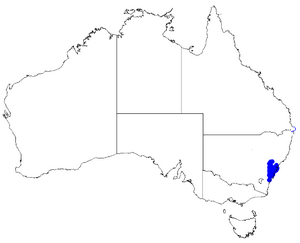Pale pink boronia facts for kids
Quick facts for kids Pale pink boronia |
|
|---|---|
 |
|
| White flower form Garigal National Park | |
 |
|
| Pink flower form at Mount Wilson | |
| Scientific classification | |
 |
|
| Occurrence data from Australasian Virtual Herbarium |
The Boronia floribunda, also known as the pale pink boronia, is a special plant. It belongs to the citrus family, called Rutaceae. You can only find this plant in certain coastal areas of eastern New South Wales, Australia.
This plant is a tall, woody bush. It has unique leaves made of smaller parts. In spring and early summer, it blooms with many white or pale pink flowers. Each flower has four petals.
Contents
What the Pale Pink Boronia Looks Like
The pale pink boronia is a woody shrub that grows upright. It usually reaches a height of about 0.5 to 1 meter (1.6 to 3.3 feet).
Leaves and Flowers
The leaves of this plant are quite interesting. Each leaf has five, seven, or nine small, narrow leaflets. The leaflet at the very end is usually the shortest. These leaflets are about 4 to 25 millimeters (0.16 to 0.98 inches) long. They are also about 1.5 to 3 millimeters (0.06 to 0.12 inches) wide. The whole leaf, including its stalk (called a petiole), is about 13 to 35 millimeters (0.51 to 1.38 inches) long. The petiole itself is about 3 to 7 millimeters (0.12 to 0.28 inches) long.
The flowers are usually white or pale pink. Sometimes, they can be a deeper pink color. They grow in groups of up to nine flowers where the leaves meet the stem. Each flower has four triangular sepals. These are small leaf-like parts that protect the flower bud. They are about 2.5 to 3.5 millimeters (0.10 to 0.14 inches) long. The four petals are larger, about 6 to 15 millimeters (0.24 to 0.59 inches) long.
Reproduction and Fruit
Inside the flower, there are eight stamens. These are the parts that produce pollen. The tips of the stamens are hairy. When you look closely, these hairs form a small raised ring. The stigma, which is the part that receives pollen, is noticeably swollen.
The pale pink boronia mainly flowers from September to January. After flowering, it produces small fruits. These fruits are smooth and measure about 3 to 5 millimeters (0.12 to 0.20 inches) long. They are also about 2.5 to 3 millimeters (0.10 to 0.12 inches) wide.
Naming the Pale Pink Boronia
The scientific name for this plant, Boronia floribunda, was first officially described in 1825. It was described by Heinrich Gustav Reichenbach. He used notes from an earlier, unpublished work by Franz Sieber. The description was then published in a book called Iconographia Botanica Exotica.
The second part of its scientific name, floribunda, comes from a Latin word. It means "abounding in flowers" or "flowering profusely." This name likely refers to how many flowers this plant produces.
Where the Pale Pink Boronia Lives
This type of boronia grows in specific areas. You can find it in heathlands and forests. It prefers areas with sandstone soil in the Sydney region of Australia. Some of the places where it grows include Garigal National Park, Ku-ring-gai Chase National Park, Blue Mountains National Park, and Nattai National Park.

